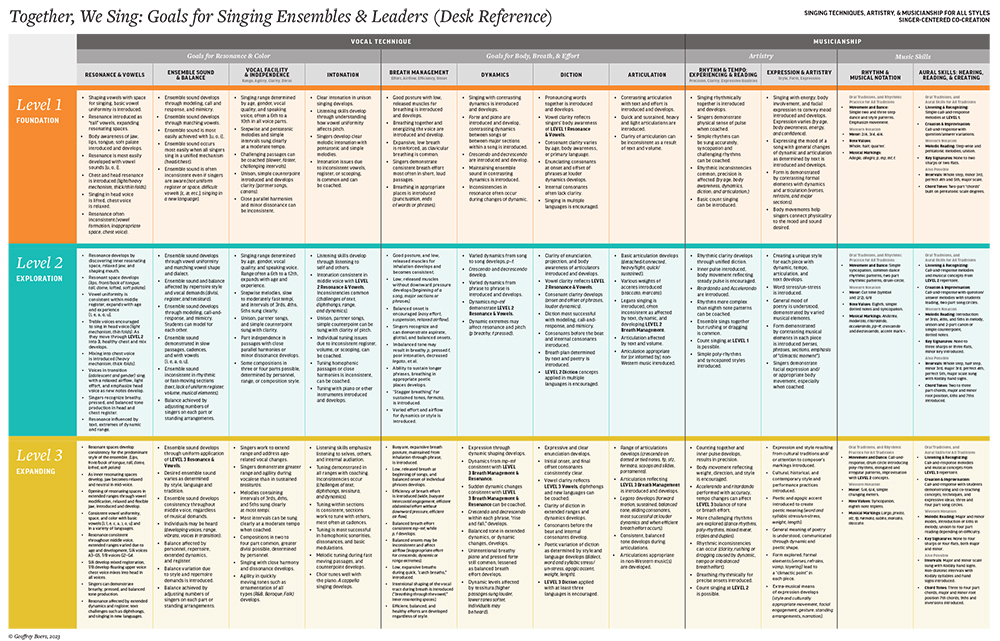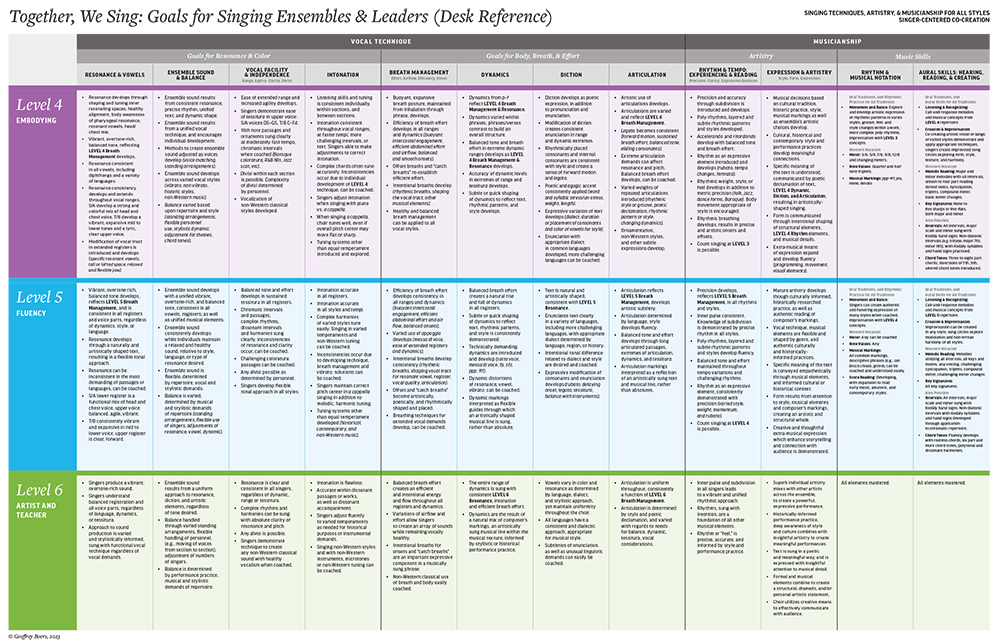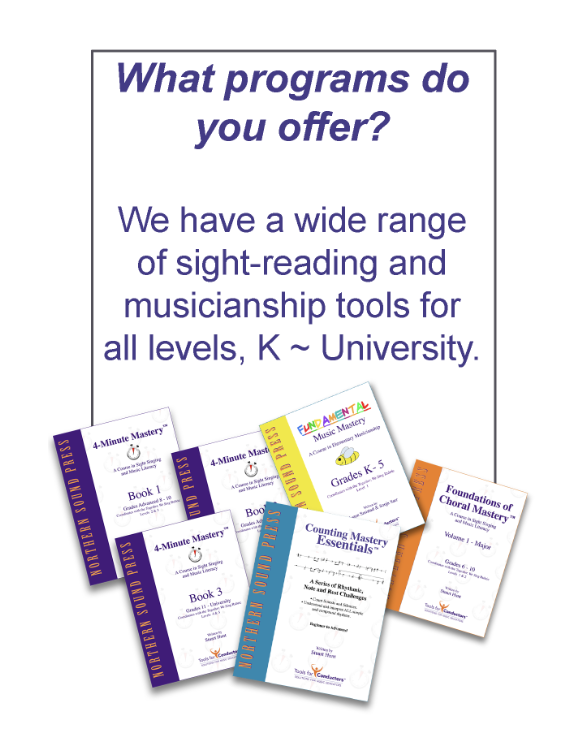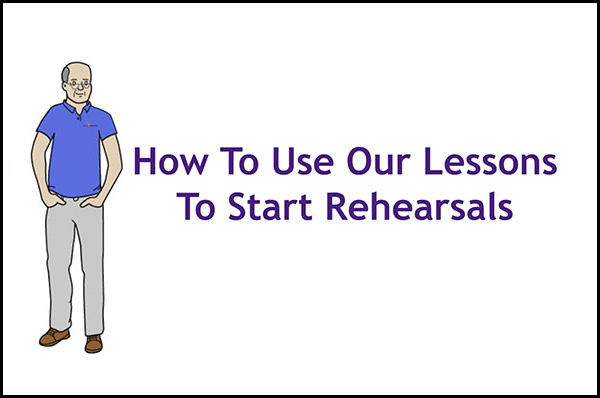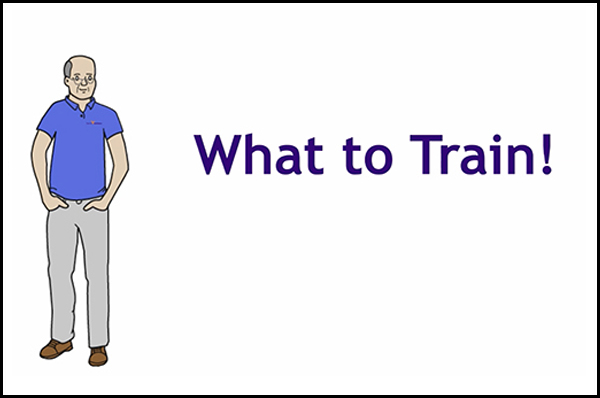Sight-Reading in Festivals and Contests:
Planning Ahead
By Stuart Hunt
with additional comments by Dr. Geoffrey Boers
This post arises from what started as a discussion between two choral conductors—Dr. Geoffrey Boers (Director of Choral Studies, University of Washington) and Stuart Hunt (ToolsforConductors.com)—on how we define choral literacy, and eventually led to a four-year partnership and the
Boers’ “Together, We Sing-Pathways for Group Singing.”
See below for samples – You can have it FREE !
Formerly known as CLaS, Choral Literacies and Skills this reference work has been re-tooled and updated to bring rich and diverse methods and skills to an even wider range of singer and teachers! Each of us maintained our focus on our individual strengths. Here, our narratives co-mingle to offer encouragement about starting up again.
During this time of year, many of us are planning for a new and more “normal” year ahead. This coming year could be like no other, that is, a time to restart and retool. You may be considering what repertoire you will do, as well as what musicianship development texts you may use. In addition, you may have been in touch with district and regional colleagues and to discuss and be involved in preliminary planning for festivals and contests. An important consideration as we explore what will be possible next year is to focus on a perennial point of discussion, perhaps even contention, that is, making the decision to include or require sight-reading as a component of the event. Further, decisions need to be made whether sight-reading is required or optional, and judged or not.
Regardless, it must be a positive educational experience for students and conductors. This process requires rehearsal time investment and commitment to actually teach sight-reading and music literacy to prepare the growth experience. But why would that be extra work or an “add-on” to rehearsals and not a component of every rehearsal that truly facilitates growth and artistic expression?
Dr. Geoffrey Boers, Director of Choral Activities at the University of Washington, has spent a career addressing literacy by focusing on what techniques and tools are needed so that students can feel like literate and expressive singers and artists. In the last four years he has created a rubric of descriptors that define these techniques and tools. These specific descriptions become goals for teachers, and markers of development in twelve areas of literacy. These markers of development define excellence and success regardless of level of singing, be it novice, emerging, and experienced singers and ensembles. He shares these words:
“The remote, distance, asynchronous, distanced, masked, Zoom environment that became our classrooms during the COVID pandemic, challenged our teaching, inhibited the natural development of our ensembles, and exposed some inconvenient truths in our choral art. It became clear that we excelled at developing ensembles, but struggled to focus on the individual; we worked on choral ‘tone’ but not individual singing technique; we worked on ‘musicality’ without focusing on individual artistry; and we were adept at teaching ‘songs’ and less efficient teaching the skills—both musicianship and vocal technique—necessary to learn them. As I led countless teacher workshops focusing on how to transition to teach in these new ways it was evident that the majority of teachers realized that without a group in front of them, teaching was nigh impossible?
“How do we teach an ensemble we cannot hear; how can we teach musical skills without the repertoire? The answer was simple—look at repertoire in a different way: “What can each piece teach our ensemble with regard to vocal techniques, music reading skills, and artistic expression?
“As we look at the ‘teachables’ that lie within each piece, we move from trying to teach music, and turn to teaching kids. Seeing each singer in their separate box, and we, as the conductor, in just another box amongst them, can inspire us to change the paradigm of our classroom. Warm-ups can turn into ‘Tech-Time’ to build necessary skills specific to the repertoire we will do, and necessary skills to ‘own’ for a lifetime of music making. Sight-singing time can move into specific musical application of reading rhythms, harmony, and artistic symbols along with part reading. Rehearsal of the music becomes a time to imbed the Tech Time techniques into the technique of each singer—repeatable, reliable, lifetime skills. Learning the song happens as we focus on the growth of each individual student.
“But this is a big ask—to rethink and retool our pedagogy. Together, We Sing was created, perhaps serendipitously, for such a retooling. It is a rubric for choral skills to help you teach literacy in music reading, vocal technique, and artistry. In each area, students can learn and be successful as artists and readers and singers from the very beginning. The rubric can show students (and we teachers) what skills are necessary to be the best we can be at every level of development. The rubric informs teachers to ensure that as you teach whatever vocal pedagogy or tradition you want to, it will be in a healthy way. Rather than merely being ‘musical,’ the rubric outlines goals for the developing artist, regardless of style. Beyond note reading, the rubric ensures that a broad array of symbols, rhythms, and harmonies are explored.
“Together, We Sing can assist in other ways as well. As we move to become a more diverse culture with accessibility for all, this document encourages us to go beyond being diverse in multicultural repertoire, and to be truly global in our teaching. We can become more collaborative, more student-centered, with multiple possible outcomes. We can take more time to reach every student in their individual way as they partner with us to decide the next goals. The rubric can show even the most advanced student that it will take a lifetime to achieve all of the goals on the rubric. The collaborative and ‘all sounds are possible’ nature of this guide takes the pressure and focus off of the teacher to perfect repertoire, and turns it toward a shared vision of the joy of the process, and that the success of the ensemble will be a result of the individual growth of each person—even the teacher!
“Lastly, Together, We Sing”gives us a vehicle to accurately assess student growth. Perhaps the most common way that teachers assess student performance, other than giving a group grade based on the performance of the ensemble, is to assess quartets. Typically, this process assesses the progress of how well a piece is learned. It does not account for individual growth, what a particular student might be working on, and is merely an assessment of part learning. Together, We Sing enables you to focus on two to three literacies, and then assess your students on the performance of the literacy, regardless of repertoire. This assessment can be done as rehearsal goes along without disruption. Since I am no longer focused on group ‘tone’ for example, I much more often ask individuals to sing for the group, to teach us, and share what they can do. Together, we gently work through a technical issue and celebrate a rehearsal’s worth of growth. Other students celebrate and affirm them as well, and grow more by hearing them than listening to me.
“I will always remember the little Zoom boxes, and that I am only one more of them, that my position in the choir is in the midst of them, and that we are not working just on some inanimate piece of music that is outside of us. We are exploring and teaching each other, modeling and reflecting, celebrating and growing. Together, We Sing provides an unending array of teaching possibilities and teaching literacy independent of your repertoire chosen, teaching method preferred, and level of students in your ensemble. Together, We Sing has been described as ‘agnostic,’ meaning without bias or agenda. It gives us the information we need not only to lead toward literacy, but to open the door toward diversity in teaching.”
WHAT IS TO BE GAINED?
When choirs prepare for any type of adjudication or festival, preparation begins as much
as a year in advance in areas like the following:
√ music selection
√ admin approval
√ venue and acoustics
√ possible overnight and attendant arrangements
√ equipment transport
√ transportation of students
√ paperwork and verification
√ food arrangements
√ chaperones
We can all agree that the overriding concern and focus should be expanded musical experience and validation. Some programs limit their literature for months to maximize their score. That is certainly a different discussion, but, if that is the case, one is justified in asking the following:
• Why spend 3-5 months on the same three or four songs?
• Is a significant portion of that time devoted to teaching by rote?
• What are the choristers actually “learning”?
• Wouldn’t investing a few minutes of each rehearsal in sight-reading training and music literacy be just as effective and yield greater, longer-lasting returns?
A three- to four-minute focus on rhythmic training, interval recognition, or part-singing (with expression markers) is a problem-solver. Studied, prepared, focused sight-reading on a challenge the choir will encounter in the literature solves problems before they occur. Transfer to similar encounters is more likely to occur with this awareness and solution training than if rehearsals are just singing /fixing/singing again.
Practice does not make perfect; it makes permanent. What and how you rehearse grows or fails to grow great choirs. This focused training includes:
√ understanding both time and key signatures
√ training eyes to look ahead
√ recognizing and practicing rhythmic figures
√ audiating intervals before singing them
√ understanding expression markings
√ expanding your view to see the shape of the phrase, not just individual notes or rhythms
√ recognizing the era/style/genre of the music and how that affects interpretation
√ focusing on/solving particular problem spots
√ locating and deferring to the melody from part to part
√ practicing excellent vocal technique regardless of what one sings
In an article for ACDA’s Choral Journal (May 2001) entitled “Adjudicated Sight-Reading for the Choral Ensemble: An Incentive for Musical Literacy,” author Matthew Armstrong of Warburg College considers the implications of two studies by Ohio choral conductors of Ohio choral programs:
“The results of these two studies reflect my experience as a music educator and adjudicator. School and community expectations often dictate the performance demands of a music program, and directors resort to rote techniques to meet the demand quickly and efficiently. We inhibit the musical development of our students, however, and in part limit their future success when we fail to maintain a focus on musical literacy. The demand for choral groups to perform will not go away and, indeed, the application of skills through performance should be a primary objective in a quality choral curriculum. A rehearsal approach that leads to the mastery of literature while facilitating musical literacy is needed” (p. 26).
Just three to four minutes per rehearsal can, after specific training, emphasize one particular skill, all of which starts in sight-reading time and, most importantly, builds confidence in the singer(s) each rehearsal as the choir recognizes the challenges are increasing and they can meet them. And, hey . . . IT’S FUN!
How do colleagues in your region feel about adjudicated (not necessarily scored) festival sight-reading? Have you collectively discussed/decided that? As presented above, the work has been done for you. CLaS rhythmic, intervallic and part-singing practice, adjudication lines and judging forms are free. Running a 20-minute sight- reading clinic (when choirs are ready to get started shortly after getting settled in the room) is enjoyable and affirming. I have had conductors shed tears because they were so surprised and validated as their choir’s time expired. Imagine coming out of an adjudication wanting to sight-read more! How much rehearsal time could that save? How much true music education could be accomplished?
Stuart Hunt is the founder of sight-reading and music literacy ToolsforConductors.com and is now completing his 53 rd year as a conductor and music educator. He can be contacted at stuart@northernsoundpress.com
Dr. Geoffrey Boers is Director of Choral Activities at the University of Washington in Seattle, a program widely recognized as forward thinking, unique, and of great distinction. Under his direction, the graduate choral program has developed a singular mission: to nurture the whole student as conductor-teacher-servant-leader-scholar. He can be contacted at: boersg@uw.edu. Dr. Boers’ Together, We Sing-Pathways for Group Singing. Formerly known as CLaS, Choral Literacies and Skills has been re-tooled and updated to being rich and diverse methods and skills to an even wider range of singer and teachers.
It is FREE to you. Click here to order:
